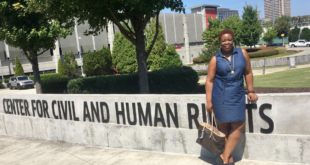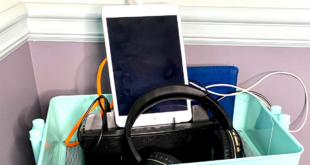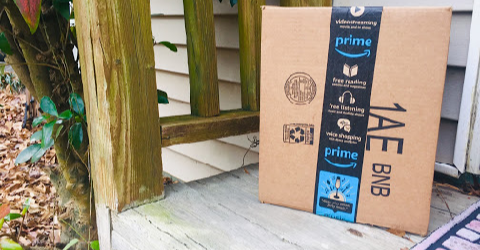Many of you know I had a career in local TV news before I launched this site, my YouTube channel and started working with family-friendly brands. You know the reporters you see standing on the side of the road during a snow storm showing you the snow plows headed out to work? I was THAT reporter. You’ve seen the reporters who get sent to cover a shooting at 10 p.m. and go live to give you the latest details on the search for the shooter. I was THAT reporter. After your Thanksgiving meal when you turned on the local news to see all the long shopping lines for Black Friday. I was THAT news anchor delivering the news. I’ve worked in local television newsrooms on my birthday, Thanksgiving, Christmas, New Year’s Eve, New Year’s Day, 9/11 and most significantly in my career – I was at work as a Mississippi TV News Anchor when Hurricane Katrina came ashore.
But first some background.
In July 2005, I covered my first Hurricane on the Mississippi coast. Forecasters were watching Hurricane Dennis. My news director assigned me and the chief photographer to drive about three hours South to coastal Mississippi. We stayed in a local hotel and went outside in the windy wet conditions to cover the hurricane. I remember how deserted Biloxi, Mississippi was as we drove around. Residents took cover, stayed off the streets and let the emergency responders handle the situation. It was a typical hurricane. Little did I know how this was a sad look into the much more devastating future of coastal Mississippi.
Ironically, I’d interviewed for a job at WLOX-TV along the Mississippi coast in 2002. But I took the job as an anchor, three hours north in Jackson, Mississippi. If things had worked out differently, I may have lost my home.
So the weekend of August 29, 2005 me and my colleagues at 16 WAPT-TV reported in to work on a Sunday as we’d done on many previous storm weekends. I knew it would be a long night. But I had not idea it would be a long week, month, summer….for the state to recover.
Journalists from our sister station in New Orleans, WDSU evacuated to our station in Jackson to take cover the storm. Their station and TV tower were damaged badly. For awhile, they were only able to stream live on their TV station’s website. I will never forget when the first aerial video came in to the newsroom showing the devastation in New Orleans. I watched as each of the Louisiana journalist looked for their homes and neighborhoods – they were ALL underwater.

Thousands of evacuees from coastal Mississippi and Louisiana did the same thing. Our metropolitan area of about 250,000 had now doubled. Hotels were sold out. Evacuees took refuge in the city’s coliseum.
To give our local audience and all of the evacuees the news the needed – where to get help, what their hometowns look like, when they could return home, when power would be restored, where gas stations HAD power to pump gas, when fuel trunks would be able to deliver more gas – our TV station turned into a mini-CNN. We did wall to wall 24 hour coverage of the storm. When you work 12, 14 or even a 20 hour shift at work covering a storm you forget to eat. So our general manager’s church members sent us food. Good southern food lined the hallways like it was Thanksgiving everyday.
16 WAPT-TV had the smallest news staff of any of the local stations. To help us, our corporate office sent in help from stations along the East Coast. I even had a flashback moment when my University of Missouri classmate Michelle Baker, from our sister station in South Carolina, showed up to help. Michelle is a Jackson native so it was easy for her to send out crews and assign stories. Thankfully, generators kept us on the air. But we had no working bathrooms. Portablae potties lined the backyard of the station.
By day five or six, I felt exhausted and overwhelmed. My family called non-stop wondering how I was doing since I was in Mississippi alone. We worked round the clock, then came home to no power. Most people don’t realize that even hundreds of miles away from the coast in places like Jackson, we went without power for a week or more thanks to Katrina’s spinoff tornados.
My breaking point came when I was co-anchoring the evening news with Scott Simmons. Our producer told us in our earpiece that a rescue helicopter in New Orleans that was trying to provide help – had crashed. We tossed live to coverage in Louisiana. And that was my breaking point.
I could not allow any more words about destruction and dead people to come out of my mouth.
The words stopped.
The sobbing started.
I put my head down on the anchor desk and let it all out.
Scott continued anchoring the newscast without me. My buddy in the studio, Justin McCray, peeled me off the anchor desk and helped me outside to get some fresh air.
I know my stress was nothing like the people who’d lost their homes. But I felt it. I read it. I shared in on the air for hours everyday.
Then I wondered if I was really doing enough. I really didn’t think I was…until I went to the Mississippi Coliseum to cover a story.
Think of it as the New Orleans Superdome on a much smaller scale. Hundreds of evacuees were sleeping in cots on the floor, using public bathrooms to keep clean and wondering when life would ever return to normal.
I’d barely gotten into the front door before a man with a thick Louisiana accent walked up to me and said, “Newslady, Newslady. They let you OUT of the station?! Who’s gonna give us the news? We’ve been watching you non-stop, Newslady. We knew where to get help because we saw it on your news, Newslady. Thank you, Newslady.”
It changed my attitude. I was doing ENOUGH. I was helping and our 24 hour coverage of the Katrina aftermath was just what they needed.
The next month, I was home in New York to celebrate my Mom’s 70th birthday. I’d already arranged for us to have tickets to see ABC’S The View. My news director emailed the producers to tell them that I’d be in the audience. Fast forward to the day of the show where then-co-host Meredith Vieira interviewed me live on the show about our wall-to-cover coverage. It was my first of two appearances on the talk show.
The next year, our station won a Southeast Regional Emmy award for Best Daily News Cast and for Best Breaking News Coverage of the devastating storm.
We didn’t have iPhones back then. Otherwise, I probably would have more photos and documentation of what happened. From what I could “dust off,” I found this YouTube video where you can fast forward to about 3:40 and watch my coverage of a storm relief project that helped Mississippi and Florida storm victims.
Video: Mississippi Storm Relief Project
My last day working in Mississippi was August 22, 2009. I moved here to Atlanta to join me fiance, now husband, since he has a TV job here.

Join me in remembering the devastation and the recovery in Mississippi and Louisiana. The Weather Channel has a Then and Now photography page with breathtaking images.
 Mommy Talk Show Candid Conversation with a TV Mom
Mommy Talk Show Candid Conversation with a TV Mom



